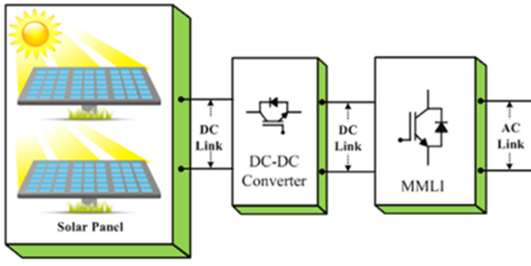Performance investigation of modular multilevel inverter topologies for photovoltaic applications with minimal switches
DOI:
https://doi.org/10.20998/2074-272X.2022.6.05Keywords:
fast Fourier transform, multilevel inverter, photovoltaic, pulse width modulation techniques, total harmonic distortionAbstract
Introduction. In recent years, a growing variety of technical applications have necessitated the employment of more powerful equipment. Power electronics and megawatt power levels are required in far too many medium voltage motor drives and utility applications. It is challenging to incorporate a medium voltage grid with only one power semiconductor that has been extensively modified. As a result, in high power and medium voltage settings, multiple power converter structure has been offered as a solution. A multilevel converter has high power ratings while also allowing for the utilization of renewable energy sources. Renewable energy sources such as photovoltaic, wind, and fuel cells may be readily connected to a multilevel inverter topology for enhanced outcomes. The novelty of the proposed work consists of a novel modular inverter structure for solar applications that uses fewer switches. Purpose. The proposed architecture is to decrease the number of switches and Total Harmonic Distortions. There is no need for passive filters, and the proposed design enhances power quality by creating distortion-free sinusoidal output voltage as the level count grows while also lowering power losses. Methods. The proposed topology is implemented with MATLAB / Simulink, using gating pulses and various pulse width modulation methodologies. Moreover, the proposed model also has been validated and compared to the hardware system. Results. Total harmonic distortion, number of power switches, output voltage and number of DC sources are compared with conventional topologies. Practical value. The proposed topology has been very supportive for implementing photovoltaic based multilevel inverter, which is connected to large demand in grid.
References
Khoun-Jahan H. Switched Capacitor Based Cascaded Half-Bridge Multilevel Inverter With Voltage Boosting Feature. CPSS Transactions on Power Electronics and Applications, 2021, vol. 6, no. 1, pp. 63-73. doi: https://doi.org/10.24295/CPSSTPEA.2021.00006.
Grandi G., Loncarski J., Dordevic O. Analysis and Comparison of Peak-to-Peak Current Ripple in Two-Level and Multilevel PWM Inverters. IEEE Transactions on Industrial Electronics, 2015, vol. 62, no. 5, pp. 2721-2730. doi: https://doi.org/10.1109/TIE.2014.2363624.
Lingom P.M., Song-Manguelle J., Mon-Nzongo D.L., Flesch R.C.C., Jin T. Analysis and Control of PV Cascaded H-Bridge Multilevel Inverter With Failed Cells and Changing Meteorological Conditions. IEEE Transactions on Power Electronics, 2021, vol. 36, no. 2, pp. 1777-1789. doi: https://doi.org/10.1109/TPEL.2020.3009107.
Ezhilvannan P., Krishnan S. An Efficient Asymmetric Direct Current (DC) Source Configured Switched Capacitor Multi-level Inverter. Journal Européen Des Systèmes Automatisés, 2020, vol. 53, no. 6, pp. 853-859. doi: https://doi.org/10.18280/jesa.530611.
Siddique M.D., Mekhilef S., Rawa M., Wahyudie A., Chokaev B., Salamov I. Extended Multilevel Inverter Topology With Reduced Switch Count and Voltage Stress. IEEE Access, 2020, vol. 8, pp. 201835-201846. doi: https://doi.org/10.1109/ACCESS.2020.3026616.
Saeedian M., Adabi M.E., Hosseini S.M., Adabi J., Pouresmaeil E. A Novel Step-Up Single Source Multilevel Inverter: Topology, Operating Principle, and Modulation. IEEE Transactions on Power Electronics, 2019, vol. 34, no. 4, pp. 3269-3282. doi: https://doi.org/10.1109/TPEL.2018.2848359.
Sandeep N., Yaragatti U.R. Design and Implementation of a Sensorless Multilevel Inverter With Reduced Part Count. IEEE Transactions on Power Electronics, 2017, vol. 32, no. 9, pp. 6677-6683. doi: https://doi.org/10.1109/TPEL.2017.2681739.
Suresh K., Parimalasundar E. A Modified Multi Level Inverter With Inverted SPWM Control. IEEE Canadian Journal of Electrical and Computer Engineering, 2022, vol. 45, no. 2, pp. 99-104. doi: https://doi.org/10.1109/ICJECE.2022.3150367.
Jahan H.K., Panahandeh F., Abapour M., Tohidi S. Reconfigurable Multilevel Inverter With Fault-Tolerant Ability. IEEE Transactions on Power Electronics, 2018, vol. 33, no. 9, pp. 7880-7893. doi: https://doi.org/10.1109/TPEL.2017.2773611.
Haji-Esmaeili M.M., Naseri M., Khoun-Jahan H., Abapour M. Fault-Tolerant and Reliable Structure for a Cascaded Quasi-Z-Source DC–DC Converter. IEEE Transactions on Power Electronics, 2017, vol. 32, no. 8, pp. 6455-6467. doi: https://doi.org/10.1109/TPEL.2016.2621411.
Kiran Kumar G., Parimalasundar E., Elangovan D., Sanjeevikumar P., Lannuzzo F., Holm-Nielsen J.B. Fault Investigation in Cascaded H-Bridge Multilevel Inverter through Fast Fourier Transform and Artificial Neural Network Approach. Energies, 2020, vol. 13, no. 6, art. no. 1299. doi: https://doi.org/10.3390/en13061299.
Belbachir N., Zellagui M., Settoul S., El-Bayeh C.Z., Bekkouche B. Simultaneous optimal integration of photovoltaic distributed generation and battery energy storage system in active distribution network using chaotic grey wolf optimization. Electrical Engineering & Electromechanics, 2021, no. 3, pp. 52-61. doi: https://doi.org/10.20998/2074-272X.2021.3.09.

Downloads
Published
How to Cite
Issue
Section
License
Copyright (c) 2022 E. Parimalasundar, N. M. G. Kumar, P. Geetha, K. Suresh

This work is licensed under a Creative Commons Attribution-NonCommercial 4.0 International License.
Authors who publish with this journal agree to the following terms:
1. Authors retain copyright and grant the journal right of first publication with the work simultaneously licensed under a Creative Commons Attribution License that allows others to share the work with an acknowledgement of the work's authorship and initial publication in this journal.
2. Authors are able to enter into separate, additional contractual arrangements for the non-exclusive distribution of the journal's published version of the work (e.g., post it to an institutional repository or publish it in a book), with an acknowledgement of its initial publication in this journal.
3. Authors are permitted and encouraged to post their work online (e.g., in institutional repositories or on their website) prior to and during the submission process, as it can lead to productive exchanges, as well as earlier and greater citation of published work.




